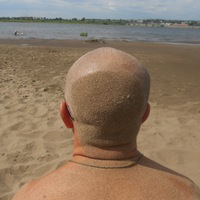Знак на мосту через реку Урал в селе Кизильское, Челябинская область. Урал в этом месте совсем узкий, можно переплыть.
https://ru.wikipedia.org/wiki/Граница_между_Европой_и_Азией#/maplink/8
Немного истории
Граница Европы и Азии с VI века до н. э. к нашему времени испытала значительное перемещение с запада на восток. Древние греки проводили её приблизительно в центральной части Средиземного моря. Позже, в 524—457 годах до н. э., границей стали считать Керченский пролив и реку Танаис (Дон). Большой научный авторитет Птолемея явился причиной того, что это представление прочно утвердилось и не изменялось до XVIII века.
В 1730 году шведский учёный Филипп Иоганн фон Страленберг впервые обосновал в мировой научной литературе идею о проведении границы между Европой и Азией. Позднее в 1736 году В. Н. Татищев утверждал, что именно он подсказал Страленбергу эту мысль. Татищев обосновал в своей книге проведение этой границы от пролива Югорский Шар по Уральскому хребту, по реке Урал, разделяя такие города, как Орск и Оренбург (в их нынешних границах), через Каспийское море до реки Кумы, через Кавказ, Азовское и Чёрное моря в Босфор.
Эта идея не сразу получила признание современников и последователей. Так, например, Михаил Ломоносов в трактате «О слоях земных» (1757—1759) проводил рубеж между Европой и Азией по Дону, Волге и Печоре. Однако вскоре появились авторы, исследования которых вслед за Татищевым стали признавать Уральский хребет в качестве естественного рубежа между Европой и Азией.
Граница между Европой и Азией с севера на юг проходит по Уральским горам, затем по реке Эмба до Каспийского моря, севернее Кавказа — по рекам Кума и Маныч до Азовского моря, далее — по Чёрному, Мраморному и Средиземному морям. Описанная выше граница не является бесспорной — это лишь один из нескольких принятых в мире вариантов.
Подробнее о других местах пересечения Европы и Азии и о современной границе https://ru.wikipedia.org/wiki/Граница_между_Европой_и_Азией
https://ru.wikipedia.org/wiki/Граница_между_Европой_и_Азией#/maplink/8
Немного истории
Граница Европы и Азии с VI века до н. э. к нашему времени испытала значительное перемещение с запада на восток. Древние греки проводили её приблизительно в центральной части Средиземного моря. Позже, в 524—457 годах до н. э., границей стали считать Керченский пролив и реку Танаис (Дон). Большой научный авторитет Птолемея явился причиной того, что это представление прочно утвердилось и не изменялось до XVIII века.
В 1730 году шведский учёный Филипп Иоганн фон Страленберг впервые обосновал в мировой научной литературе идею о проведении границы между Европой и Азией. Позднее в 1736 году В. Н. Татищев утверждал, что именно он подсказал Страленбергу эту мысль. Татищев обосновал в своей книге проведение этой границы от пролива Югорский Шар по Уральскому хребту, по реке Урал, разделяя такие города, как Орск и Оренбург (в их нынешних границах), через Каспийское море до реки Кумы, через Кавказ, Азовское и Чёрное моря в Босфор.
Эта идея не сразу получила признание современников и последователей. Так, например, Михаил Ломоносов в трактате «О слоях земных» (1757—1759) проводил рубеж между Европой и Азией по Дону, Волге и Печоре. Однако вскоре появились авторы, исследования которых вслед за Татищевым стали признавать Уральский хребет в качестве естественного рубежа между Европой и Азией.
Граница между Европой и Азией с севера на юг проходит по Уральским горам, затем по реке Эмба до Каспийского моря, севернее Кавказа — по рекам Кума и Маныч до Азовского моря, далее — по Чёрному, Мраморному и Средиземному морям. Описанная выше граница не является бесспорной — это лишь один из нескольких принятых в мире вариантов.
Подробнее о других местах пересечения Европы и Азии и о современной границе https://ru.wikipedia.org/wiki/Граница_между_Европой_и_Азией
A sign on a bridge over the Ural River in the village of Kizilskoye, Chelyabinsk Region. The Urals in this place are very narrow, you can swim across.
https://ru.wikipedia.org/wiki/Border_between_Europe_and_Asia#/maplink/8
A bit of history
Border of Europe and Asia from the 6th century BC e. by now it has experienced a significant movement from west to east. The ancient Greeks carried it out approximately in the central part of the Mediterranean Sea. Later, in 524-457 BC. e., the Kerch Strait and the Tanais (Don) River began to be considered the border. The great scientific authority of Ptolemy was the reason that this idea was firmly established and did not change until the 18th century.
In 1730, the Swedish scientist Philip Johann von Stralenberg for the first time substantiated in the world scientific literature the idea of drawing a border between Europe and Asia. Later in 1736 V.N. Tatishchev claimed that it was he who suggested this idea to Stralenberg. Tatishchev substantiated in his book the drawing of this border from the Yugorsky Shar Strait along the Ural ridge, along the Ural River, dividing cities such as Orsk and Orenburg (within their present borders), across the Caspian Sea to the Kuma River, through the Caucasus, the Azov and Black Seas to Bosphorus.
This idea was not immediately recognized by contemporaries and followers. For example, Mikhail Lomonosov in his treatise On the Layers of the Earth (1757-1759) drew the line between Europe and Asia along the Don, Volga and Pechora. However, soon there were authors whose studies, following Tatishchev, began to recognize the Ural Range as a natural border between Europe and Asia.
The border between Europe and Asia from north to south runs along the Ural Mountains, then along the Emba River to the Caspian Sea, north of the Caucasus - along the Kuma and Manych rivers to the Sea of Azov, then along the Black, Marmara and Mediterranean seas. The border described above is not indisputable - it is only one of several options accepted in the world.
More about other places of intersection of Europe and Asia and about the modern border https://ru.wikipedia.org/wiki/Border_between_Europe_and_Asia
https://ru.wikipedia.org/wiki/Border_between_Europe_and_Asia#/maplink/8
A bit of history
Border of Europe and Asia from the 6th century BC e. by now it has experienced a significant movement from west to east. The ancient Greeks carried it out approximately in the central part of the Mediterranean Sea. Later, in 524-457 BC. e., the Kerch Strait and the Tanais (Don) River began to be considered the border. The great scientific authority of Ptolemy was the reason that this idea was firmly established and did not change until the 18th century.
In 1730, the Swedish scientist Philip Johann von Stralenberg for the first time substantiated in the world scientific literature the idea of drawing a border between Europe and Asia. Later in 1736 V.N. Tatishchev claimed that it was he who suggested this idea to Stralenberg. Tatishchev substantiated in his book the drawing of this border from the Yugorsky Shar Strait along the Ural ridge, along the Ural River, dividing cities such as Orsk and Orenburg (within their present borders), across the Caspian Sea to the Kuma River, through the Caucasus, the Azov and Black Seas to Bosphorus.
This idea was not immediately recognized by contemporaries and followers. For example, Mikhail Lomonosov in his treatise On the Layers of the Earth (1757-1759) drew the line between Europe and Asia along the Don, Volga and Pechora. However, soon there were authors whose studies, following Tatishchev, began to recognize the Ural Range as a natural border between Europe and Asia.
The border between Europe and Asia from north to south runs along the Ural Mountains, then along the Emba River to the Caspian Sea, north of the Caucasus - along the Kuma and Manych rivers to the Sea of Azov, then along the Black, Marmara and Mediterranean seas. The border described above is not indisputable - it is only one of several options accepted in the world.
More about other places of intersection of Europe and Asia and about the modern border https://ru.wikipedia.org/wiki/Border_between_Europe_and_Asia


У записи 17 лайков,
1 репостов,
883 просмотров.
1 репостов,
883 просмотров.
Эту запись оставил(а) на своей стене Елена Орлова





































